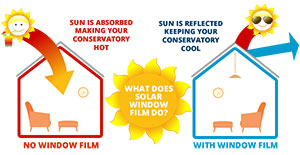Fading of Furnishings
Typical double-glazed tinted windows reduce UV penetration into your conservatory by up to 90 percent, according to The Energy Savings Centre. This decrease in UV radiation helps to increase the life of your furnishings by reducing fading and degradation.
The addition of roof blinds particularly in spring & summer, significantly reduces the UV transmission further, with our Solar Energi roof roller fabric allowing less than 1% to be transmitted through it, whilst the very best quality pleated fabrics eg Hunter Douglas “Topar” allows 4% through.
Electromagnetic Spectrum & UV

Fading of conservatory furnishings is usually attributed to ultraviolet radiation (UV) from the sun passing through windows. However, UV is not the only portion of the elecro-magnetic spectrum which can damage furnishings inside conservatories. Virtually the whole spectrum has fading potential in varying degrees.
Large Glazed Areas
Supported by the highly energy efficient low-emissivity glasses, conservatories tend to have large numbers of windows with technically advanced roof & window glass. However, whilst glass such as Pilkington k helps keep conservatories warmer in winter by retaining heat, they actually make them hotter in summer! Consumers also drive this trend, with their demand for large, open interior spaces flooded with natural light, but this then necessitates the installation of thermally efficient blinds that reduce or largely eliminate fading.
Fragile Fabrics
While this trend has brought more light into conservatories, and in many cases energy savings due to reduced electric lighting usage, another trend has, at the same time, made interior fabrics and finishes more fragile: the emergence of environmentally friendly materials.
In addition, because of ozone depletion, higher levels of solar UV now reach the surface of the earth. This further contributes to the rate of fading.
Ultraviolet Radiation Damage
The sun's energy is made up of three distinct spectral components: ultraviolet radiation, visible radiation, and near-infrared radiation. What distinguishes these from one another is the wavelength ranges that define them, commonly measured in nanometers (nm). A nanometer is ultra tiny: a human hair is over 100,000 nanometers thick.
UV radiation is invisible to the human eye and has the shortest wavelengths of the three types, from 300 to 380 nm. Visible light covers the approximate range from 380 to 780 nm, while the near infrared radiation (or “invisible solar heat”) has the longest wavelengths, from 780 to 4045 nm. UV is the biggest contributing factor in fading of fabrics, carpets and other furnishings with about 40% of the damage. Visible light, electric lighting, heating, humidity, age of fabrics, wear & physical abrasion and fabric dyes all account for the remaining 60% of the damage. Protecting against UV is not just important on hot, sunny days. Even on cold, cloudy days, UV radiation can damage furnishings.
